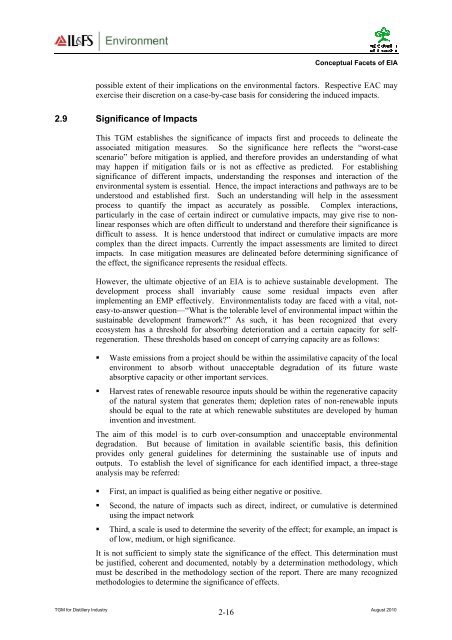Distillieries - Environmental Clearance
Distillieries - Environmental Clearance
Distillieries - Environmental Clearance
Create successful ePaper yourself
Turn your PDF publications into a flip-book with our unique Google optimized e-Paper software.
Conceptual Facets of EIApossible extent of their implications on the environmental factors. Respective EAC mayexercise their discretion on a case-by-case basis for considering the induced impacts.2.9 Significance of ImpactsThis TGM establishes the significance of impacts first and proceeds to delineate theassociated mitigation measures. So the significance here reflects the “worst-casescenario” before mitigation is applied, and therefore provides an understanding of whatmay happen if mitigation fails or is not as effective as predicted. For establishingsignificance of different impacts, understanding the responses and interaction of theenvironmental system is essential. Hence, the impact interactions and pathways are to beunderstood and established first. Such an understanding will help in the assessmentprocess to quantify the impact as accurately as possible. Complex interactions,particularly in the case of certain indirect or cumulative impacts, may give rise to nonlinearresponses which are often difficult to understand and therefore their significance isdifficult to assess. It is hence understood that indirect or cumulative impacts are morecomplex than the direct impacts. Currently the impact assessments are limited to directimpacts. In case mitigation measures are delineated before determining significance ofthe effect, the significance represents the residual effects.However, the ultimate objective of an EIA is to achieve sustainable development. Thedevelopment process shall invariably cause some residual impacts even afterimplementing an EMP effectively. <strong>Environmental</strong>ists today are faced with a vital, noteasy-to-answerquestion—“What is the tolerable level of environmental impact within thesustainable development framework?” As such, it has been recognized that everyecosystem has a threshold for absorbing deterioration and a certain capacity for selfregeneration.These thresholds based on concept of carrying capacity are as follows:Waste emissions from a project should be within the assimilative capacity of the localenvironment to absorb without unacceptable degradation of its future wasteabsorptive capacity or other important services.Harvest rates of renewable resource inputs should be within the regenerative capacityof the natural system that generates them; depletion rates of non-renewable inputsshould be equal to the rate at which renewable substitutes are developed by humaninvention and investment.The aim of this model is to curb over-consumption and unacceptable environmentaldegradation. But because of limitation in available scientific basis, this definitionprovides only general guidelines for determining the sustainable use of inputs andoutputs. To establish the level of significance for each identified impact, a three-stageanalysis may be referred:First, an impact is qualified as being either negative or positive.Second, the nature of impacts such as direct, indirect, or cumulative is determinedusing the impact networkThird, a scale is used to determine the severity of the effect; for example, an impact isof low, medium, or high significance.It is not sufficient to simply state the significance of the effect. This determination mustbe justified, coherent and documented, notably by a determination methodology, whichmust be described in the methodology section of the report. There are many recognizedmethodologies to determine the significance of effects.TGM for Distillery Industry August 20102-16

















